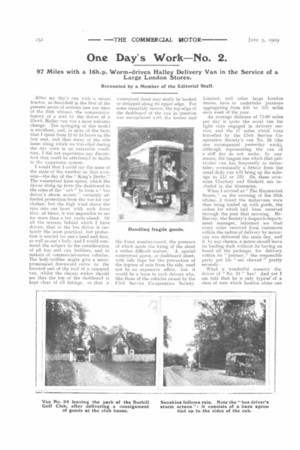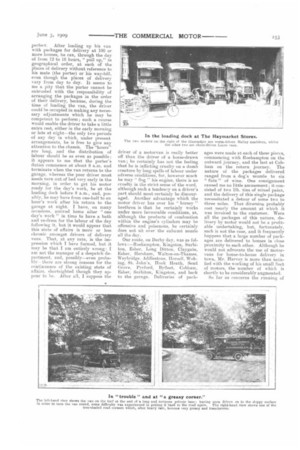One Day' s Work No. 2.
Page 4

Page 5

Page 6

If you've noticed an error in this article please click here to report it so we can fix it.
97 Miles with a 16h.p. Worm-driven Halley Delivery Van in the Service of a Large London Stores.
Recounted by a Member of the Editorial Staff.
After my day's run with a steam tractor, as described in the first of the present series of articles (see our issue of the 20th ultimo), the comparative luxury of a seat by the driver of a 25cwt. Halley van was a most welcome change. The springing of this mock' is excellent, and, in spite of the facts that I spent from 12 to 14 hours on the box seat, and that many of the side lanes along which we travelled during the day were in an execrable condition, I did not experience any discomfort that could be attributed to faults in the suspension system. I would that I could say the same of the state of the weather on that occasion—the day of the " King's Derby." The waterproof knee apron, which the driver slung up from the dashboard to the sides of the " cab " to form a " bus driver's storm screen," certainly afforded protection from the wet for our clothes, but the high wind drove the rain into our faces with such force that, at times, it was impossible to see for more than a few yards ahead. Of all the screens behind which I have driven, that of the bus driver is certainly the most practical, but protection is needed for one's head and face, as well as one's body, and I would commend the subject to the consideration of all bus and van builders, and to makers of commercial-motor vehicles. The body-builder might give a morepronounced downward curve to the forward end of the roof of a canopied van, whilst the chassis maker should see that the top of the dashboard is kept clear of all fittings, so that a waterproof sheet may easily be hooked or strapped along its upper edge. For some unearthly reason, the top edge of the dashboard of the van in question was encumbered with the hooter and the front number-board, the presence of which made the fixing of the sheet a rather difficult matter. A special waterproof apron, or dashboard sheet, with side flaps for the prevention of the ingress of rain from the side, need not be an expensive affair, but it would be a boon to such drivers who, like those of the vehicles owned by the Civil Service Co-operative Society, Limited, and other large London Stores, have to undertake journeys aggregating from 450 to 550 miles each week of the year.
An average distance of 75-90 miles per day is quite the usual run for light vans engaged in delivery service, and the 97 miles which were travelled by the Civil Service Cooperative Society's van No. 24 (the one accompanied yesterday week), although representing the run of a still day do not make, by any means, the longest one which that particular van has frequently to undertake ; occasionally a detour from the usual daily run will bring up the mileage to 115 or 120. On these occasions Chertsey and Oxshott are included in the itineraries.
When I arrived at" The Haymarket Stores," on the morning of the 26th ultimo, I found the motorvans were then being loaded up with goods, the orders for which had been received through the post that morning. Mr. Harvey, the Society's despatch-department manager, informed me that every order received froni customers within the radius of delivery by motorvan was delivered the same day, and if, by any chance, a motor should leave its loading dock without its having on board all the packages for delivery within its "journey," the responsible party got his "ear chewed " pretty severely.
What a wonderful memory the driver of "No. 24 " has! And yet I am told that he is only typical of a class of men which London alone can
perfect. After loading up his van with packages for delivery at 100 or more houses, he can, through the day of from 12 to 16 hours, "pull up," in geographical order, at each of the places of delivery without reference to his mate (the porter) or his way-bill, even though the places of delivery vary from day to day. It seems to me a pity that the porter cannot be entrusted with the responsibility of arranging the packages in the order of -their delivery, because, during the time of loading the van, the driver could be occupied in making any necessary adjustments which he may be competent to perform; such a course would enable the driver to take a little extra rest, either in the early morning or late at night—the only two periods of any day in which, under present arrangements, he is free to give any attention to the chassis. The "hours" are long, and the distribution of labour should be as even as possible ; it appears to me that the porter's duties commence at about 8 a.m. and terminate when the van returns to the garage, whereas the poor driver must needs turn out of bed very early in the morning, in order to get his motor ready for the day's work, he at the loading dock before 8 a.m., and, possibly, he may have from one-half to an hour's work after his return to the garage at night. I have, on many occasions, arrived home after " one day's work" in time to have a bath and re-dress for the labour of the day following it, but it would appear that this state of affairs is more or less chronic amongst drivers of delivery vans. That, at any rate, is the impression which I have formed, but it may be that I am entirely wrong : I am not the manager of a despatch department, and, possibly--even probably— there are strong reasons for the continuance of the existing state of affairs, shortsighted though they appear to be. After all, I suppose the driver of a motorvan is really better off than the driver of a horse-drawn van ; he certainly has not the feeling that he is inflicting cruelty on a dumb creature by long spells of labour under adverse conditions, for, however much he may " flog " his engine, there is no cruelty in the strict sense of the word, although such a tendency on a driver's part should most certainly be discouraged. Another advantage which the motor driver has over his " horsey " brethren is that he certainly works under more favourable conditions, as, although the products of combustion within the engine's cylinders may be offensive and poisonous, he certainly does not sit over the exhaust nozzle all the clay.
Our route, on Derby day, was as follows :—Roehampton, Kingston, Surbiton, Esher, Long DittAm, Claygate, Esher, Hersha.m, Walton-on-Thames, Weybridge. A dd lestone , Hot-soil, Woking, St. John's, Hook Heath, Send Grove, Pyrford, Bytleet, Cobham, Esher, Surbiton, Kingston, and back to the garage. Deliveries of pack ages were made at each of these placcs, commencing with Itoeliampton on the outward journey, and the last at Cobham on the return journey. The nature of the packages delivered ranged from a dog's muzzle to six " flats " of wine. One consignment caused me no little amusement ; it consisted of two 11b. tins of mixed paint, and the delivery of this single package necessitated a detour of some two to three miles. That diversion probably cost nearly the amount at which it was invoiced to the customer. Were all the packages of this nature, delivery by motor would not be a profitable undertaking, but, fortunately, such is not the case, and it frequently happens that a large number of packages are delivered to houses in close proximity to each other. Although he would not advocate the use of motorvans for house-to-house delivery in town, Mr. Harvey is more than satisfied with the working of his small fleet of motors, the number of which is shortly to be considerably augmented.
So far as concerns the running of
the motor on the road during the day's work, I have nothing but praise ; in spite of the shocking state of the sandy Surrey lanes, due to the heavy showers of the previous day and during our run, the second-speed gear was the lowest which was found necessary for the negotiation of any of the hills and very soft by-lanes encountered during the day. Of mechanical mishap or incident there was none—the engine continued to run with a regularity which was almost monotonous, but, as for starting it after a short stop—well! I wished I'd had Mr. George Halley with me on that day ; probably he "knows the trick." There was no sign of the seizing-up of any part ; it was simply a question of the compression's holding up in a remarkable manner, even when the half-compression cam was in operation. Ender such conditions, one of a pair of Ca. inch pistons, with well-fitted rings, is not easily" driven home," but, having once been started, the engine has plenty of power, whilst the remaining details of the chassis, which was Hills
trated and described in detail in our issue of the 19th November last, are equally sound and capable of standing up to the loads imposed and to the very hard usage to which such a motor is subjected during the distribution of merchandise over a large country service.
The Halley 25cwt. van can run an average of 12 miles on a gallon of petrol ; other charges for general stores, the replacement of parts, " running " repairs and general upkeep are equally light..




















